V-ing作状语讲课教案
V-ing形式的运用的教学设计
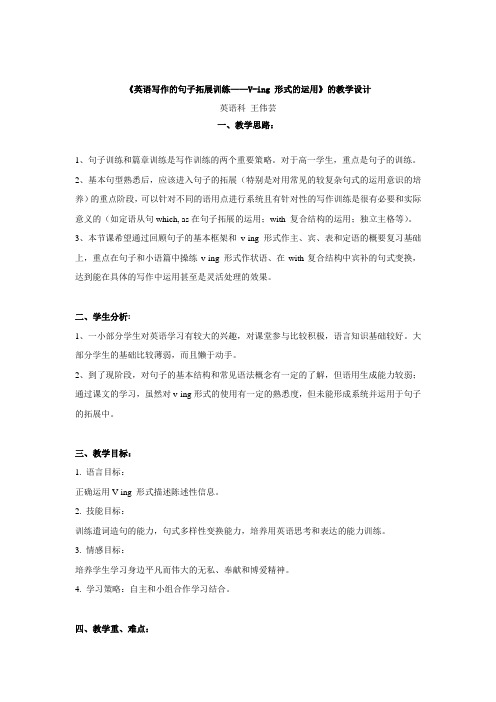
Sample one: Long ago, there was a lovely beauty. She lived there. As she was so beautiful, she was deeply
My masterpiece: __________________________________________________________________________
二、学生分析: 1、一小部分学生对英语学习有较大的兴趣,对课堂参与比较积极,语言知识基础较好。大 部分学生的基础比较薄弱,而且懒于动手。 2、到了现阶段,对句子的基本结构和常见语法概念有一定的了解,但语用生成能力较弱; 通过课文的学习,虽然对 v-ing 形式的使用有一定的熟悉度,但未能形成系统并运用于句子 的拓展中。
三、教学目标: 1. 语言目标: 正确运用 V-ing 形式描述陈述性信息。 2. 技能目标: 训练遣词造句的能力,句式多样性变换能力,培养用英语思考和表达的能力训练。 3. 情感目标: 培养学生学习身边平凡而伟大的无私、奉献和博爱精神。 4. 学习策略:自主和小组合作学习结合。
四、教学重、难点:
重点:学会正确运用 v-ing 形式在实际句子拓展中,并开展有效的写作学习活动。 难点:通过引导学生在句式转换和仿写,提高遣词造句等综合语言运用能力;在两个句子或
means
①
②
③
focusing on pursuing an ideal university.We enjoy helping each other. Working as a team is
现在分词v-ing状语公开课PPT教学课件

8
Being poor, he couldn’t afford a house.
原因
9
His father died, leaving a large sum of money.
结果
10
They walked out of the building,
talking and smiling.
判断下列句子的正误: ①. Hearing the news, tears ran down her face. ①. Hearing the news, she cried. ②. Looking out through the window, the garden was beautiful. ②. Looking out through the window, I found the garden was beautiful.
hero, she decided to study harder.
Moved by the hero,
16
and Exploration 2: 现在分词作状语存在时态和语态变化
doing
2 Guidance
主动
语 态
having done being done
被动
having been done
现在分词作状语
v-ing used as adverbial
1
1、非谓语使用条件 一个句子当中,已经存在一个主句 (谓语动词),又没有连词的情况下
She got off the bus, but left her handbag on her seat. She got off the bus, leaving her handbag on her seat.
现在分词(V-ing)作定语和状语

现在分词(V-ing)作定语和状语现在分词(V-ing)作定语和状语语法聚焦(现在分词作定语和状语)课前预习案学习建议:根据所列例句,理解并尝试总结现在分词在句子中的用法。
动词--ing形式作定语和状语I.ing 形式作定语1. 现在分词作前置定语时,在逻辑上与所修饰的名词之间为主谓关系,也可改成定语从句;如果与所修饰的名词之间没有主谓关系,定语相当于一个介词for引导的短语。
现在分词位于所修饰的名词之后做后置定语,与所修饰的名词之间呈逻辑上的主谓关系,相当于一个定语从句。
如:a listening child= a child who is listening, a walking stick= a stick for walking.2. 现在分词作定语往往表示“令人……”,主动的或正在进行的动作。
如:a moving film, a developing country.II. ing 形式作状语动词-ing形式在句子中做状语,表示的动作是主语动作的一部分,与谓语动词表示的动作或状态是同时或者几乎同时发生的,经常可以做时间、原因、方式、条件、结果、目的、让步状语从句。
句子的主语必须是状语的逻辑主语;而且主语与作状语的分词之间呈逻辑上的主谓关系。
1.原因状语,相当于原因状语从句。
1).Being ill, she didn’t go to school today.因为生病,她今天没上学去。
2). Seeing no one at home, I decided to come again.看见没有人在家,我决定再来一趟。
2. 时间状语,相当于when, while等引导的从句。
1).Hearing the good news, he jumped with joy.当听到这个好消息时,他高兴地跳了起来。
2).Walking in the street, I saw a friend of mine.当我走在街上时,我看到了我的朋友。
语法V-ing学案
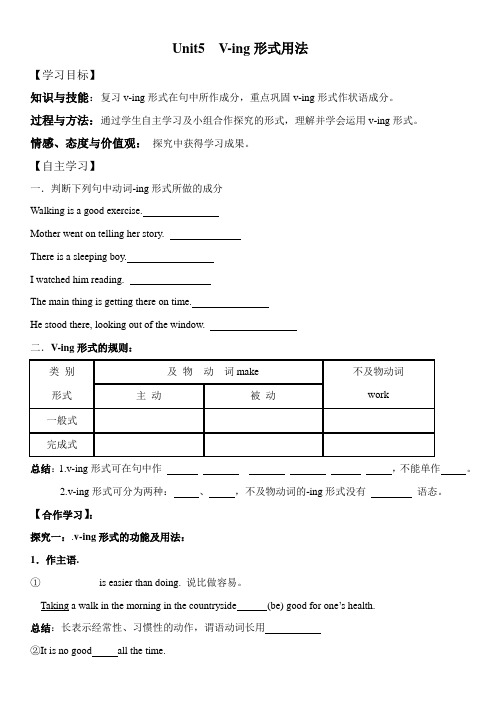
Unit5 V-ing形式用法【学习目标】知识与技能:复习v-ing形式在句中所作成分,重点巩固v-ing形式作状语成分。
过程与方法:通过学生自主学习及小组合作探究的形式,理解并学会运用v-ing形式。
情感、态度与价值观:探究中获得学习成果。
【自主学习】一.判断下列句中动词-ing形式所做的成分Walking is a good exercise.Mother went on telling her story.There is a sleeping boy.I watched him reading.The main thing is getting there on time.He stood there, looking out of the window.二.V-ing形式的规则:总结:1.v-ing形式可在句中作,不能单作。
2.v-ing形式可分为两种:、,不及物动词的-ing形式没有语态。
【合作学习】:探究一:.v-ing形式的功能及用法:1.作主语.①___________ is easier than doing. 说比做容易。
Taking a walk in the morning in the countryside (be) good for one’s health.总结:长表示经常性、习惯性的动作,谓语动词长用②It is no good all the time.A. complaining B complained C. Complain D. to complain总结:句中it作,把真正的主语-- 移置句尾,但仅限于以下结构中可以这样用:It is no use\ no good\ doing sth (尽可能多写)提示:当动名词用作主语时,其逻辑主语由形容词性物主代词和名词所有格构成。
1. 我姐姐病了,使我很担心。
being ill made we worried.2. to the station on time made everyone worried last week.A. Him not gettingB. Not his gettingC. His not gettingD. Not getting2. 作宾语(1)常跟在某些动词后作宾语E.g I remember (lock) the door before I left the office, but forget to turn off the lights.(2)常跟在某些动词短语后作宾语E.g He insisted on (walk) to school everyday.(3)常用在某些句型中作宾语:E.g I have difficulty in (learn) English well.(4)I found no use .(和他谈话)总结:有时用作形式宾语,而把真正宾语置于句尾。
v-ing 作定语和状语学案
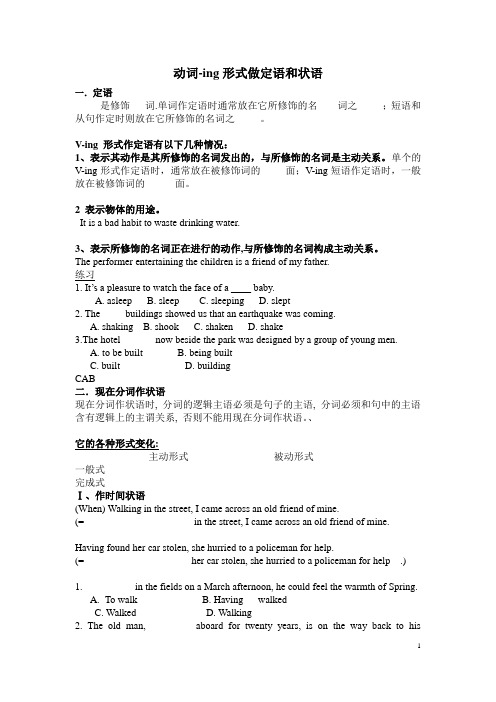
动词-ing形式做定语和状语一.定语是修饰___词.单词作定语时通常放在它所修饰的名词之_____;短语和从句作定时则放在它所修饰的名词之_____。
V-ing 形式作定语有以下几种情况:1、表示其动作是其所修饰的名词发出的,与所修饰的名词是主动关系。
单个的V-ing形式作定语时,通常放在被修饰词的_____面;V-ing短语作定语时,一般放在被修饰词的______面。
2 表示物体的用途。
It is a bad habit to waste drinking water.3、表示所修饰的名词正在进行的动作,与所修饰的名词构成主动关系。
The performer entertaining the children is a friend of my father.练习1. It’s a pleasure to watch the face of a ____ baby.A. asleepB. sleepC. sleepingD. slept2. The ____ buildings showed us that an earthquake was coming.A. shakingB. shookC. shakenD. shake3.The hotel ______ now beside the park was designed by a group of young men.A. to be builtB. being builtC. builtD. buildingCAB二.现在分词作状语现在分词作状语时, 分词的逻辑主语必须是句子的主语, 分词必须和句中的主语含有逻辑上的主谓关系, 否则不能用现在分词作状语。
、它的各种形式变化:主动形式被动形式一般式________________ __________________完成式________________ __________________Ⅰ、作时间状语(When) Walking in the street, I came across an old friend of mine.(=______________________in the street, I came across an old friend of mine.Having found her car stolen, she hurried to a policeman for help.(= _____________________her car stolen, she hurried to a policeman for help .)1.__________ in the fields on a March afternoon, he could feel the warmth of Spring.A.To walkB. Having walkedC. WalkedD. Walking2. The old man, ________ aboard for twenty years, is on the way back to hismotherland.A.to workB. workingC. to have workedD. having worked在逻辑上,当动词-ing形式表示的动作和句子谓语动词表示的动作同时发生时用_____________________;在句子谓语动词表示的动作之前发生时用___________________________.答案:V-ing being V-edhaving V-ed having been V-edWhen I was walkingAfter she found her car stolenDDⅡ、作原因状语Being ill, he didn’t go to school(=_________________________, he didn’t go to school.)Being a student, you should study hard.(=Since you are a student, you should study hard.)Not thinking he might be at home, I called him.(=As I didn’t think he might be at home, I called him.)1. ____ a reply, he decided to write again.(NMET92)A.Not receivingB. Receiving notC. Not having receivedD. Having not received2. ______ his telephone number, she had somedifficulty getting in touch with Bill. (1991上海)A.Not knowingB. knowing notC. Not having knownD. Having not known表示原因的动词-ing 形式一般放于句首,相当于一个原因状语从句。
动词-ing 教案

非谓语动词————动词-ing形式一、教学目标1、掌握现在分词的四种基本形式。
2、掌握现在分词的时态及语态。
3、掌握现在分词的基本用法及在句中所作的成分。
二、教学重难点1、分清现在分词在句中所作成分。
2、现在分词时态和语态的选择。
3、动词-ing作状语与独立主格结构的区别。
三、教学过程(一)、导入非谓语动词定义:不能作谓语,但保留动词的某些特征的动词形式(没有人称和数的变化,有时态和语态的变化),主要有动词不定式,动名词及分词。
Eg: To see is to believe.Reading makes a full man.Barking dogs don’t bite.(二)、教学步骤动词-ing 形式时态语态主动语态被动语态现在时doing being done完成时having done having been done其否定式在肯定形式前加not动词-ing 形式时态及语态1、现在时, 表泛指的时间,不明确发生在过去现在还是将来,或表与谓语动词同时发生。
Being careless is not a good habit, whatever you do.The children surrounded the teacher, listening attentively to her story.I don’t like being laughed at in public, and I’m sure no one would do so.2、完成式,表动作发生在谓语动词前。
Having lived in New York for years, I know each part of it very well.I am very pleased at your having been chosen a member of the school volleyball team.动词-ing形式可作成分动词-ing 形式具有名词、代词、形容词、副词等特征可在句中作主语、表语、宾语、宾补、主补、定语、状语。
高一英语Unit4语法“V-ing”的用法
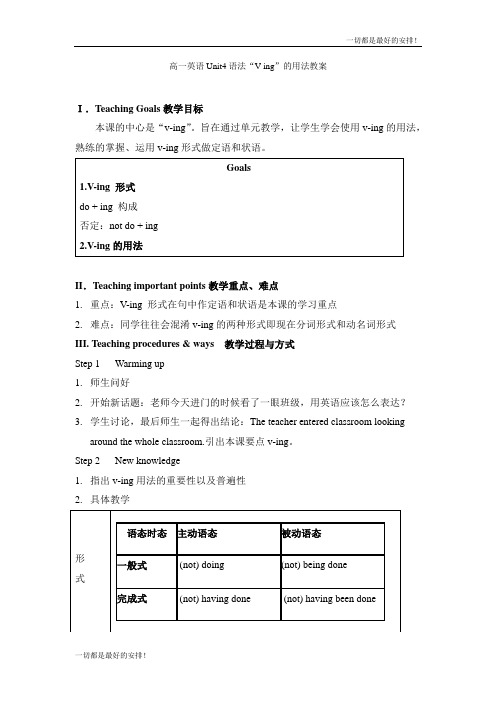
高一英语Unit4语法“V-ing”的用法教案I.Teaching Goals教学目标本课的中心是“v-ing”。
旨在通过单元教学,让学生学会使用v-ing的用法,熟练的掌握、运用v-ing形式做定语和状语。
II.Teaching important points教学重点、难点1.重点:V-ing 形式在句中作定语和状语是本课的学习重点2.难点:同学往往会混淆v-ing的两种形式即现在分词形式和动名词形式III. Teaching procedures & ways 教学过程与方式Step 1 Warming up1.师生问好2.开始新话题:老师今天进门的时候看了一眼班级,用英语应该怎么表达?3.学生讨论,最后师生一起得出结论:The teacher entered classroom lookingaround the whole classroom.引出本课要点v-ing。
Step 2 New knowledge1.指出v-ing用法的重要性以及普遍性2.具体教学Step 3 Practice1.通过翻译老师给出的句子或同学自由发挥造句练习本课要点2.通过练习题来练习本课要点练习题一、改写句子1.You see her step back and she appears surprised. = You see her step backappearing surprised.2.His nose touched Mr. Cook’s hand which is moving. = His nose touched Mr.Cook’s moving hand.3.They are visitors who come from several countries. =They are visitors comingfrom several countries.4.This is an experience which is exciting. =This is an exciting experience.二、填空1.When he approached Ms Smith, he touched her shoulder and kissed her.______ ___________ Ms Smith, he touched her shoulder and kissed her.(When approaching)2. The person who is translating the songs can speak seven languages.The person _________ ___ ______can speak seven languages.(translating the songs)3. The boy standing there is reading a book about body language.The boy ____ __ ________ there is reading a book about body language.(who is standing)4. Because he comes from Jordan, he moves close to ask you a question._______ _____ Jordan, he moves close to ask you a question.(Coming from)5. She sat at the desk and did her homework.She sat at the desk ______ ____ __________.(doing her homework)三、选择A 1. The stranger said something in a _______ voice and the little girl was verymuch ________A. frightening, frightenedB. frightened, frighteningC. frightening, frighteningD. frightened, frightenedB 2. ________the piano, someone suddenly knocked at the door.A. PlayingB. When I was playingC. RepairingD. ExaminingD 3. Mother caught the boy ______ in the corner.A. smokeB. to smokeC. being smokedD. smokingC 4. ______ the programme, they have to stay there for another 2 weeks..A. Not completingB. Not completedC. Not having completedD. Having not completedA 5. “We can’t go out in this weather”, said Bob, ____ out of the window.A. lookingB. to lookC. lookedD. having lookedKey: A B D C A。
V-ing形式当状语微课教学设计
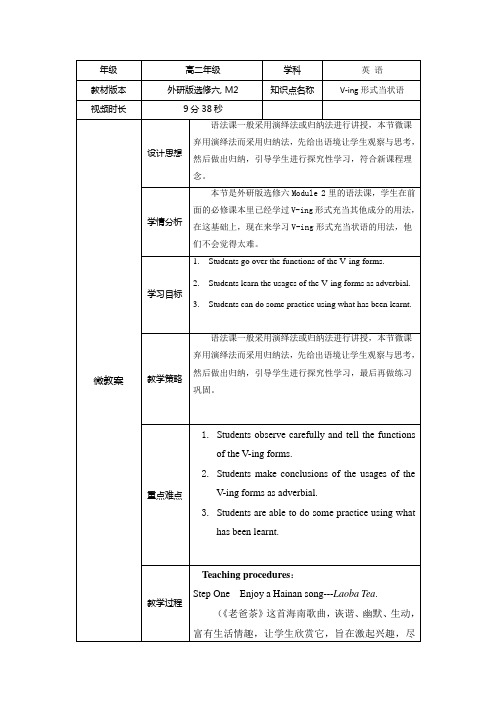
Step Seven Consolidation .1.–ing形式一般式表示该动作与谓语动作同时发生或与谓语动作紧接着发生,完成式则表示该动作发生在谓语动作之前,在句中只能作状语表示时间和原因。
2. –ing形式的主动式表示该动作是由句子主语发出,而被动式表示主语承受该动作。
3. –ing形式的否定式是在一般式和完成式的前面加not(never)。
4. –ing形式可以与when, while, if, though, once, until 等连词和介词on连用。
5. –ing形式在句中作状语时可表示时间、原因、条件、伴随状况和结果等。
通常可以改为相应的从句或并列句。
(本步骤让学生把刚学过的动词ing形式的几种情况进行再次总结,以加深印象,为下一步的应用做好准备。
)Step Eight Practice Activity 3 at Page 18 of the textbook. Match the two parts of the sentences:(本步骤让学生运用所学知识进行简单的操练,旨在让学生加深与巩固所学知识,符合新课程理念。
)Step Nine Practice again. Activity 3 at Page 21 of the textbook. Rewrite the sentences with the --ing forms of the verbs.e.g: When he returns to the palace, the king marries the woman.On returning to the palace, the king marries the woman.1.When he saw the witch, the boy ran away.2. Before he starts the war, the king speaks to the prince.3. While he was fighting in the war, the prince learnt many things.4. After he had spoken to his son, the king went to war.5. Because he doesn’t know what to do, Ferdinand follows the frog’s advice.(学生练习后,给出对照答案:)1.On seeing the witch, the boy ran away.。
V-ing 作状语公开课教案教学设计课件案例试卷

为主动关系,过去分词与主句的主语为被动关 系。
4.作结果状语
• 作结果状语时,通常放在句末,中间用逗号隔 开,表示一种顺其自然、意料之中的结果。
• The fire lasted nearly two days,leaving nothing valuable.
路的。
• Father hugged me tightly, promising that we would find a way out.
说出下列各句中动词-ing形式表示什么 状语。
(1) Using your head, you’ll find a good way. __条__件__
(2) Four people entered the room looking around in a curious way. _伴__随___
动关系,过去分词与主句的主语为被动关系。 • 由于不知怎么办,我非常焦急。
• Not knowing what to do, I paced back and forth with great anxiety.
3.作条件状语(= if/unless的条件状语从句)
• Working hard,you’ll make great progress. • =If you work hard,you’ll make great
eyes glittering with great excitement. • 2. 当我看见那只狼时,我感到很害怕。 • Catching sight of that fierce wolf, I stood
V-ing形式-学案
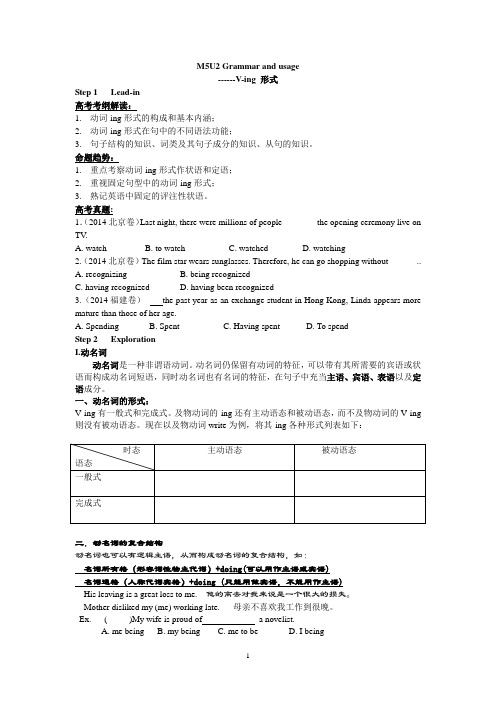
M5U2 Grammar and usage------V-ing 形式Step 1 Lead-in高考考纲解读:1.动词-ing形式的构成和基本内涵;2.动词-ing形式在句中的不同语法功能;3.句子结构的知识、词类及其句子成分的知识、从句的知识。
命题趋势:1.重点考察动词-ing形式作状语和定语;2.重视固定句型中的动词-ing形式;3.熟记英语中固定的评注性状语。
高考真题:1.(2014北京卷)Last night, there were millions of people _______ the opening ceremony live on TV.A. watchB. to watchC. watchedD. watching2.(2014北京卷)The film star wears sunglasses. Therefore, he can go shopping without ______..A. recognizingB. being recognizedC. having recognizedD. having been recognized3.(2014福建卷)the past year as an exchange student in Hong Kong, Linda appears more mature than those of her age.A. SpendingB. SpentC. Having spentD. To spendStep 2 ExplorationI.动名词动名词是一种非谓语动词。
动名词仍保留有动词的特征,可以带有其所需要的宾语或状语而构成动名词短语,同时动名词也有名词的特征,在句子中充当主语、宾语、表语以及定语成分。
一、动名词的形式:V-ing有一般式和完成式。
及物动词的-ing还有主动语态和被动语态,而不及物动词的V-ing 则没有被动语态。
(完整版)动名词作状语
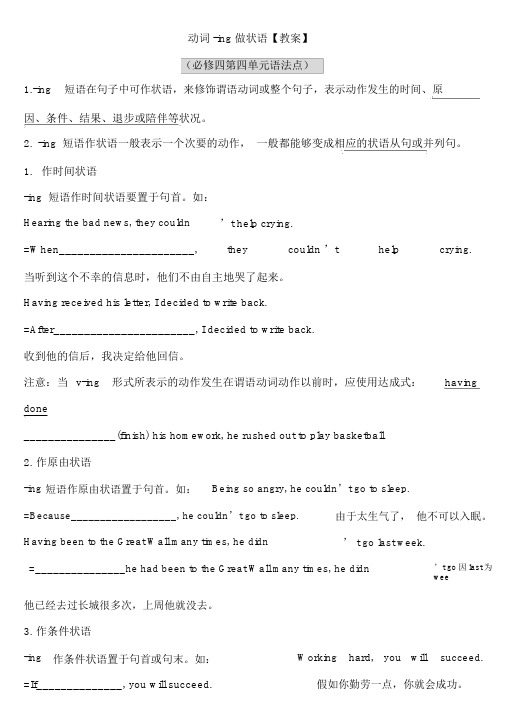
动词 -ing 做状语【教案】(必修四第四单元语法点)1.-ing短语在句子中可作状语,来修饰谓语动词或整个句子,表示动作发生的时间、原因、条件、结果、退步或陪伴等状况。
2.-ing 短语作状语一般表示一个次要的动作,一般都能够变成相应的状语从句或并列句。
1.作时间状语-ing 短语作时间状语要置于句首。
如:Hearing the bad news, they couldn’t help crying.=When______________________,they couldn’t help crying.当听到这个不幸的信息时,他们不由自主地哭了起来。
Having received his letter, I decided to write back.=After_______________________, I decided to write back.收到他的信后,我决定给他回信。
注意:当v-ing形式所表示的动作发生在谓语动词动作以前时,应使用达成式:having done_______________(finish) his homework, he rushed out to play basketball.2. 作原由状语-ing短语作原由状语置于句首。
如:Being so angry, he couldn’t go to sleep.=Because__________________, he couldn’t go to sleep.由于太生气了,他不可以入眠。
Having been to the Great Wall many times, he didn’ t go last week.=_______________he had been to the Great Wall many times, he didn’t go因last为wee他已经去过长城很多次,上周他就没去。
- 1、下载文档前请自行甄别文档内容的完整性,平台不提供额外的编辑、内容补充、找答案等附加服务。
- 2、"仅部分预览"的文档,不可在线预览部分如存在完整性等问题,可反馈申请退款(可完整预览的文档不适用该条件!)。
- 3、如文档侵犯您的权益,请联系客服反馈,我们会尽快为您处理(人工客服工作时间:9:00-18:30)。
1
学会判断teaching English. 2. His job is teaching English.
谓语动词就是指在句子中充当谓语的动词 非谓语动词指的是在句中不是谓语的动词。 谓语是对主语动作或状态的陈述或说明, 指出“ 做什么”、“是什么”或“怎么样”。
后顺序
被动
Being done(一般式)
Having been done (完成式)
否定式:在其形式前加not
Task2: V-ing作状语
由于不知道如何控制饮食,他变得越来 越胖。
Not knowing (know) how to keep a balanced diet, he became fatter.
To see the whole city , we have to get to表th被e动to,p o完f 成the
mountain.
表目的,未发生
2
V-ing作状语
Task2: V-ing作状语
状语:修饰动词、形容词、副词或整个句子,说明 动作或状态特征的句子成分。
V-ing 作状语
让步
原因
V-ing作状语
1
test yourself 找出下列非谓语动词
1. Making our city greener is everyone’s duty. 2. I'll never forget meeting my school headmaster for the first time. 3. Her job is keeping the lecture hall as clean as possible. 4. He saw a girl getting on the bus. 5. I finally solved the puzzling problem. 7.Hearing the news of their marriage, I felt heart-broken.
Task2: V-ing作状语
• 因为他们在公共场合吸烟,所以被罚款了。
1. Smoke in public 2. Fine (v.罚款)
原因
Smoking (smoke)in public, he was fined.
Task2: V-ing作状语
• 当看到你们送他的礼物,我儿子高兴地合不拢嘴。
He hurried to the station, only to be told (tell)the tickets had been sold out.
Task2: V-ing表主动时的时态语态
语态
主动
Doing(一般式)
V-ing形式的动作与谓语动 词动作几乎同时发生
V-ing形式动作先于谓语动 Having done (完成式) 词动作发生,有明显的先
时间
Seeing (see)the lovely gift you sent to him, my son felt so happy.
Task2: V-ing作状语
1. carry 2. Search for food
伴随目的
Carrying her little baby on the back, the mother Koala Bear climbs up the trees, searchingfor food.
Task2: V-ing作状语
坚持打了很多年的篮球后,焦老师变得 越来越强壮。
Having Played(play) basketball for many years, Mr.Jiao is becoming stronger and stronger.
Task2: V-ing作状语
玩了一整天电脑游戏后,他感觉昏昏沉 沉。
非谓语动词的三种形式
-ing形式
非谓语动词
过去分词 done
不定式 to do
Task1: 学会判断非谓语动词
试区分以下三种非谓语形式
Seeing from the top of the mountain, we can see the whole
city.
表主动,进行
Seen from the top of the mountain, the city is so attractive.
条件
结果
时间
伴随 方式
Task2: V-ing作状语
•尽管看到老师很失望的表情,但是他们自己做自己的事情。
1.Notice 2.Disappointed 3.Do one’s own business
让步
Noticing (notice)their teacher’s disappointed look , they do their own business.
Having played(play)computer games A whole day, he felt dazed.
3
Practice
Practice ----1
Combine the two sentences into one by using v+ing structure.
1. His father died , leaving him a lot of money. 2. He stood by the window, watching the people passing by. 3. Not knowing her address, I can’t send this book to her. 4. Living here for 4 years, I am not familiar with my neighbors. 5. Practicing more, I will do better. 6. Reading the book, she nodded from time to time.
Task2: V-ing作状语
必然结果
It has been raining for several days , d_a_m_a_g_i_n_g(damage)the Binjiang Park.
意外结果? only to do
Some of us always sleep in the class, when they wake up, only to find (find)they missed the whole class.
Task1: 学会判断非谓语动词
非谓语使用条件(试比较下列两句话,思考什么情况下才能使用非谓语动词?) 非谓语动词的使用条件: 一个句子当中,已经存在一个主句(谓语动词),又没有连词的情况下
She got off the bus but left her handbag on her seat. She got off the bus, leaving her handbag on her seat.
